The school summer holidays are in full swing and there’s no better time to do some baking with the kids! Ruby and Harry decided they would like to make some treats for their Syrian Hamster called Ginny!!
So here’s a simple recipe to make some yummy Crunchy Honey Delights!
Ingredients:
Cheerios (sugar-free kind)
Sesame Seeds
Honey
Oats

1. Add sesame seeds and oats into a bowl

2. Crush the Cheerios in a small bag, don’t crush them into dust, just small pieces
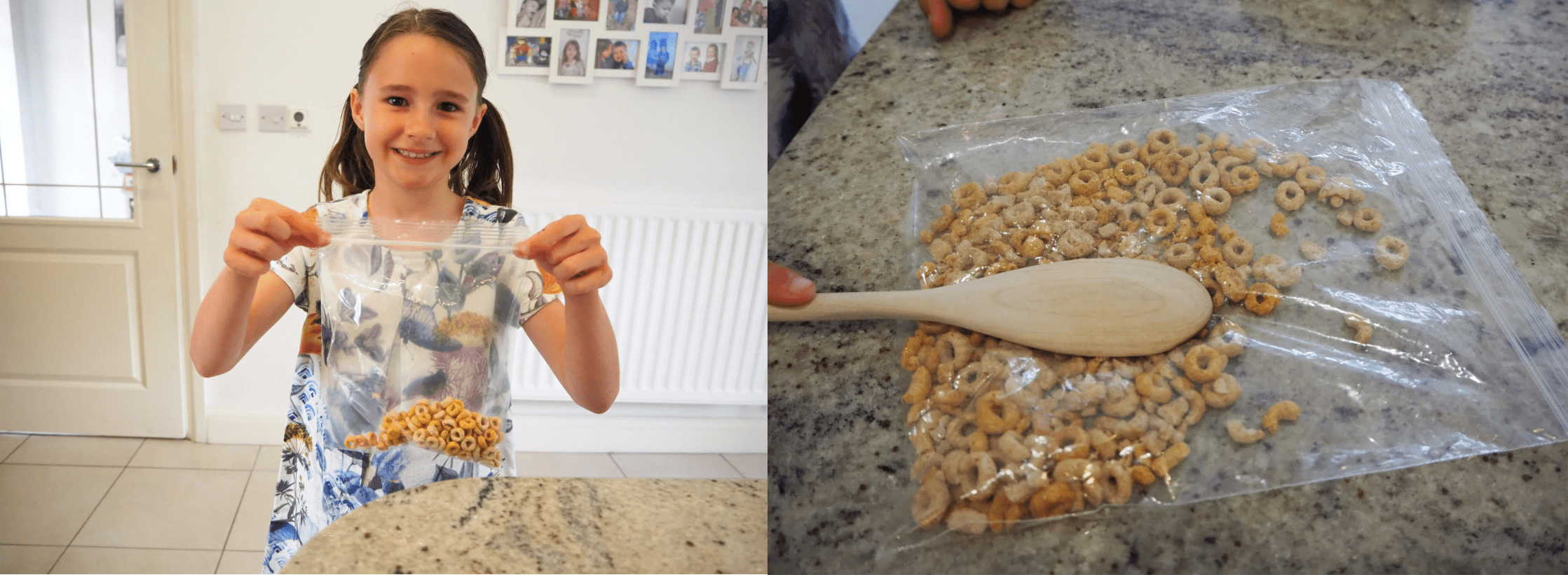
3. Add the Cheerios to the sesame seeds and oats and mix together
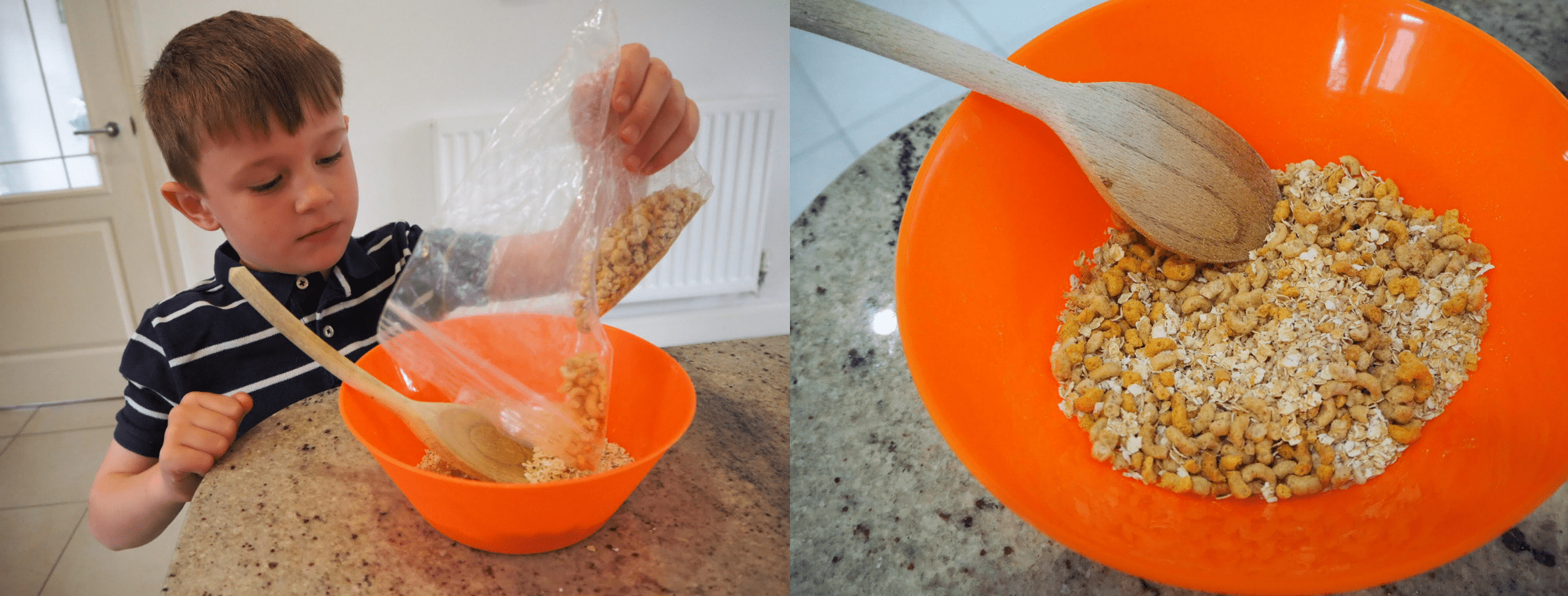
4. Drizzle honey over the mixture and coat well
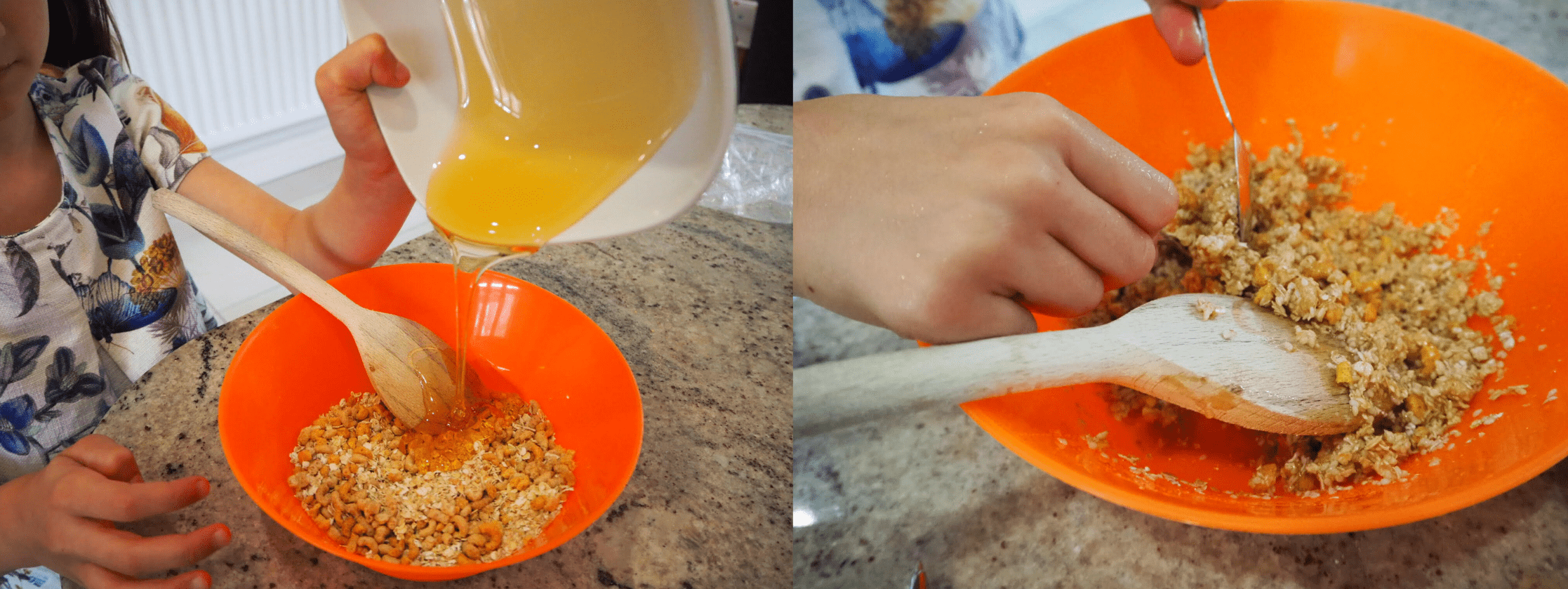
5. Use your fingers to mould the mixture into small balls that your hamster can hold,
then put them on a baking tray and into the fridge for 15 minutes

6. Heat your oven to 190 degrees and bake treats for 8-10 minutes and then let them cool completely

7. It’s time for the taste test….. does Ginny like the new treats….?

Ginny loved the Crunchy Honey Delights!
Happy Baking and remember to only give your Hamster little treats once or twice a week!
This entry was posted in Hamsters on July 31st, 2018 by helenkennedy
Raspberry & Lemon Meringue Roulade
We’ve always been fans of a super summer pavlova for dessert, but this year have been rolling up all that yumminess into a meringue roulade that guarantees a taste of all the flavours in every spoonfull!
Ingredients for meringue:
6 Eggs (whites only)
300g Caster Sugar
25g Caster Sugar for sprinkling
1 tsp Cornflour
1 tsp White Wine Vinegar
Ingredients for filling:
400ml Double Cream, whipped
Small jar Lemon Curd (homemade if possible)
2 punnets of Fresh Raspberries
Icing sugar for dusting

Method:
1) Preheat the oven to 180c, line a baking sheet with non-stick baking parchment.
2) Whisk the egg whites until they form firm peaks.
3) Sprinkle the cornflour and white wine vinegar over the whisked egg whites then add the sugar steadily whilst still whisking.
4) Spread the meringue mixture onto the lined baking tray.
5) Bake for 10 mins at 180c then turn the oven down to 160c and bake for another 10 mins until the meringue is starting to colour and is firm to touch.
6) Lay a clean tea towel on the work surface, place a sheet of parchment over the top and sprinkle with 25g caster sugar.
7) Take the baked meringue out of the oven and turn upside down on the prepared sugar dusted parchment, remove the baking sheet, allow to cool completely.
8) Once the meringue is cool, peel off the sheet of baking parchment that it was baked on and spread the whipped cream over the whole area of of the meringue.
9) Dollop/spread spoonfuls of lemon curd at regular intervals over the cream and scatter the raspberries on top.
10) Using the parchment paper for support, carefully roll the meringue to resemble a swiss roll, ensuring the parchment and tea towel don’t get caught up in the dessert!.
11) Transfer to a serving platter, dust with icing sugar and enjoy!












Recipe courtesy of Hen Corner

www.hencorner.com
This entry was posted in Recipes on July 25th, 2018 by helenkennedy

Hamsters are captivating little companions. They may be tiny, but like their cheeks, they’re packed full of character and charisma. From hamsters in the wild, to our beloved domesticated pocket pets, here are 12 interesting facts about hamsters.
1. From Syria and beyond
Hamsters are rodents from the subfamily Cricetinae. They were brought to the United States from Syria in the 1930s, but there are wild species of hamsters that populate Europe and Asia. In fact, there are at least 26 species of hamsters all over the world, but only 5 of them are docile enough to be kept as the domesticated pets we know and love today.
2. Some to handle, some to observe
While there are only 5 types of hamsters that are kept as pets, they each have very different characteristics. These different species are:
- Syrian or Golden
- Chinese
- Roborovski
- Winter White or Russian Dwarf
- Campbell’s
Some hamsters, like the Syrian, prefer to live alone, while others require a social grouping in order to thrive. Syrian hamsters and species like the Roborovski are extremely active after the sun sets – running the equivalent of a human marathon every night! Because of their tiny stature and quick strides, Roborovski hamsters aren’t ideal to handle and are best observed in their cage – but build them obstacle courses or mazes, and you can watch these pint-sized powerhouses in action.
3. Hamsters = hoarders
Hamster comes from the German word hamstern, which means “to hoard.” This is because of the pouches in hamsters’ cheeks that enable them to carry food and supplies back to their burrow. This behaviour that wild hamsters exhibit carries over into domesticated hamsters – even though it isn’t necessary for survival. You may see your hamster fervently stuffing their food bowl contents into their mouths, making their face grow two to three times larger than usual. In fact, a hamster can fit up to 20% of their body weight in their cheek pouches alone!
Some hamsters stuff one side or the other, while others will stuff both cheeks full. Their pouches don’t have salivary glands, so the food or bedding being carried in their cheeks remains dry until being deposited at its destination. If you observe your hamster regularly, you’re likely to notice them hauling their food or bedding around their enclosure this way.
4. Pups are like puppies
Like canine puppies, hamsters are born with their eyes sealed shut and their ears folded down. They’re also born without fur, with teeth that have not yet erupted from their gums. Baby hamsters are called “pups”, and develop quickly.
During the first week of age, hamster pups will begin growing their fur, and their teeth will emerge from the gum line. At 2 weeks of age, their eyes will open, followed shortly by their ears perking up around day 17 or 18. By 4 weeks old, most hamster pups are weaned, and look like miniature versions of their parents.
5. Pets with poor eyesight
Hamsters are colour-blind, and don’t have great eyesight. Interestingly, even though they’re blind to colour, they don’t see in black and white. A hamster’s eyes are made up of 97% rod cells, and just 3% cone cells, and are likely to only perceive colours on the green spectrum.
Hamsters are also very near-sighted, meaning they can’t see at a distance. This is one of the reasons why a hamster will accidentally walk off of a ledge or platform – they are unable to properly gauge distances. They can however see much better in the dark than humans, given that rod cells pull light into the retina.
6. Scent glands to guide the way
Since they don’t see particularly well, hamsters rely heavily on scent to find their way. They have scent glands which they rub on objects along a path, depositing pheromones much like a breadcrumb trail. Also called “sebaceous glands”, these pheromone-emitting glands are situated just over the hips of hamsters. These spots are more noticeable in males than females.
Hamsters can leave a scent for various reasons. Different amounts of pheromones can “bookmark” a location that a hamster wants to remember, attract a mate, or act as a territorial warning. This odour is not noticeable by humans, but the glands may be visible if your hamster has flattened the hair around them while grooming themselves or as ageing hamsters experience a thinning hair coat.
7. A too-short lifespan
Like other members of the rodent family, hamsters grow and mature quickly, and procreate efficiently, but have fairly short lifespans. Syrian hamsters live just 2-3 years in captivity – and this life expectancy is even less in the wild. Other types of domesticated hamsters have a life expectancy of 2-4 years.
Feeding your hamster a quality diet and housing them in a well-designed hamster cage will help them live their lives to the fullest. To help them get adequate exercise, be sure to bring them out of their cage several times a week. Build mazes out of cardboard, building bricks, or other material that won’t fall over on your hamster, or let them spend time in a hamster-safe playpen. Some of the most common causes of premature death in hamsters are obesity, stress, wet tail (diarrhoea) and heart disease – all of which can be mitigated through proper diet, exercise, and enclosure placement and hygiene.
8. Tiny but mighty
Hamsters range in size from the largest breed – the European hamster at 8-11 inches long, to the smallest – the Roborovski hamster at around 2 inches long. Of domesticated breeds, the Syrian hamster is the largest, coming in around 4 inches long – roughly double the size of a Roborovski hamster.
They may be small, earning them the title “pocket pets”, but hamsters are mighty little animals. They have strength, stamina, and intelligence, making them one of the most entertaining small pets to observe. Running on wheels, completing mazes, climbing through tubes, and burrowing through bedding are just some of the amazing and amusing activities of pet hamsters.
9. Ever-growing incisors
Members of the rodent family have front teeth, called incisors, that never stop growing. In hamsters with good alignment, the incisors should wear down against each other when a hamster eats. However, some hamsters’ teeth don’t line up properly, and their incisors may become overgrown as a result. If they become too long, incisors may protrude outside of the mouth, creating sores or the inability to eat properly. To combat this issue, offer your hamster apple stick chews or other hamster-safe chew toys to help whittle their teeth down.
10. Prolific procreators
The heat cycle (fertile window of females) for hamsters is based on the sun. Steady warm temperatures and long daylight hours trigger the heat cycle in female hamsters. Typical breeding seasons in the wild for hamsters take place in the spring and summer, and they can produce multiple litters in each season. However, in captivity, hamsters can breed all year long since temperatures remain constant indoors, and indoor lighting gives the illusion of sunlight.
The gestation period for hamsters is just 16-22 days depending on the breed of hamster. The average litter size is 6-8 pups (babies), although litters of up to 26 pups have been recorded.
11. Burrowing is basic
Hamsters love to burrow. In the wild, they will make their homes in the earth by digging into the substrate. The deeper a hamster can get, the more content they will be. A deep bedding tray is essential to foster this natural behaviour in domesticated hamsters.
To help your hamster burrow to their heart’s content, choose a soft, loose bedding like recycled paper or shavings (note: shavings can get caught in the fur of long-coated hamsters). Make the bedding as deep as possible, and watch as your hamster digs themselves into contentment.
12. A diverse diet
Traditionally, the diet of a hamster consists of seeds, nuts, grains, and small amounts of fruits and vegetables. In the wild, hamsters may even eat insects or small lizards, but these should never be offered to domesticated hamsters. Domesticated hamsters should be fed a pelleted diet formulated for them, or those made for mice and rats. There are “trail mix” looking diet options for hamsters that contain seeds, nuts, cracked corn, and various other treats sprinkled throughout, but hamsters will inevitably pick out their favourite pieces and leave the more nutritious offerings behind.
If you want to supplement your hamster’s diet, offer treats in small quantities and only occasionally. This will encourage them to eat their nutritious pellet feed for the majority of their diet. Some ideas for treats include:
- Leafy greens
- Apple pieces
- Cucumbers
- Seeds (such as millet or sunflower seeds)
Discover with your hamster and Omlet
We hope you found these hamster facts fascinating, and that it created a deeper desire to understand your small animal companion. Because hamsters are amazing animals, we’ve created amazing ways for you to bond with and care for your pocket pet. From the Qute Hamster Cage to our expertly curated hamster guide, we’re here to help you discover ways to interact with your hamster and create a truly joyous connection.
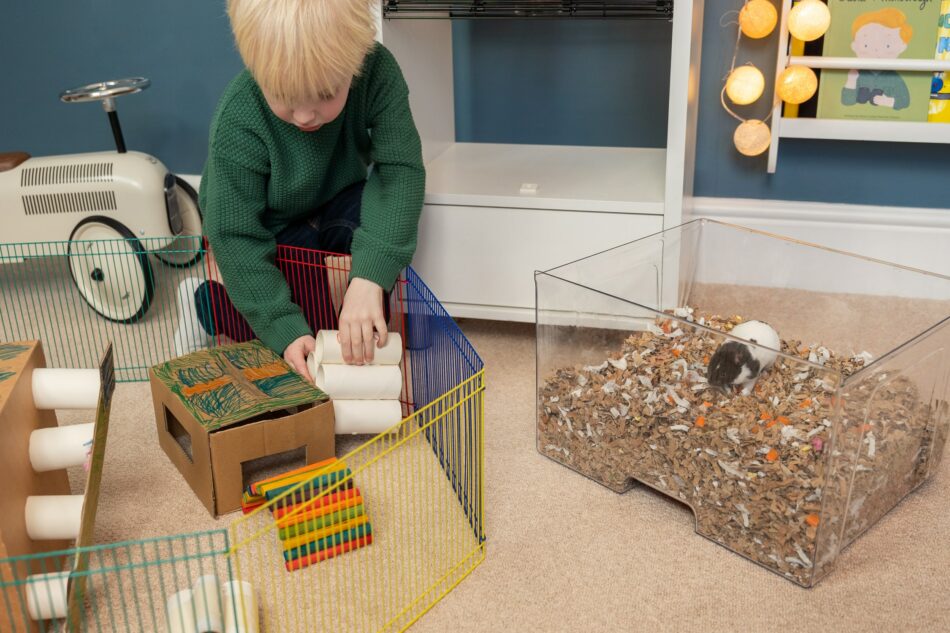
This entry was posted in Hamsters on July 24th, 2018 by helenkennedy
Many of us would agree that there are few things nicer on a hot summer’s day than a trip to the beach, and as long as you come prepared there is no reason to leave your dog at home. There are however a few things you need to do before you leave, and some things that are good to know when it comes to dogs and the beach. Whether your furry friend is a seasoned beachgoer or it’s their first time dipping their paws in the surf, here are our top tips to ensure a safe, fun, and stress-free adventure at the beach.
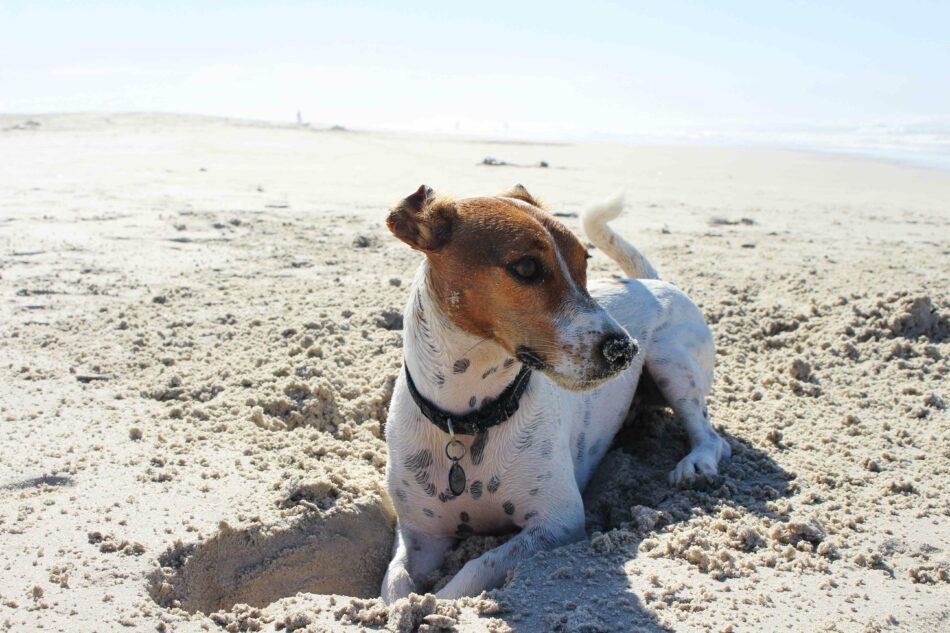
Find a dog-friendly beach
Finding the perfect dog-friendly beach can feel like striking gold for pet owners eager to share the joy of the seaside with their furry companions. The first step is to do some research. Not all beaches welcome dogs, and those that do often have specific rules regarding dog lead requirements, times of day dogs are allowed, and areas where they can roam freely. Websites and apps dedicated to pet-friendly travel can be invaluable resources, providing up-to-date information on beaches in your area or at your travel destination. Additionally, local pet owner groups and social media communities can offer first-hand insights and recommendations, helping you uncover hidden gems that might not be widely advertised.
Once you’ve identified a potential spot, it’s crucial to plan your visit to ensure a smooth and enjoyable experience. Check the beach’s amenities – look for fresh water sources, shaded areas, and designated dog zones. Knowing the tide schedule can also be beneficial, as low tide often reveals more space for your dog to explore and play. Reach out to the local authorities or the beach’s official website to confirm the latest rules and regulations, as policies can change with the seasons. By doing your homework and preparing in advance, you and your pup can look forward to a fantastic day of sun, surf, and sand, making memories that will last a lifetime.
Keep an eye on your dog
Keeping a watchful eye on your dog at the beach is crucial to ensure their safety and well-being. The open spaces and the exciting new environment can be overwhelming for your furry friend, leading them to wander off or get into trouble. It’s easy for dogs to get lost in the crowd or distracted by other animals, so maintaining visual contact at all times is essential. Consider using a brightly coloured dog collar and lead to make spotting them easier amidst the sea of sunbathers and beachgoers. If your dog is particularly adventurous or prone to wandering, investing in a GPS tracker can provide peace of mind, allowing you to keep tabs on their location in real-time.
While it’s tempting to relax and soak up the sun, staying vigilant about your dog’s activities can prevent accidents and mishaps. Watch out for hazards like sharp shells, hot sand, and strong currents that can pose a risk to their safety. Keep an eye on how much time they spend in the water to avoid overexertion or ingesting too much saltwater, which can lead to dehydration and other health issues. Be sure you bring an extra dog bowl and fresh water for them to stay hydrated. By staying alert and proactive, you can ensure your beach day remains a delightful experience for both you and your four-legged friend.
Teach your dog to swim
Many believe that all dogs know how to swim, but that simply is not the case. So while teaching your dog to swim is an exciting adventure, it does require patience, encouragement, and a bit of preparation. Start by choosing a calm, shallow area where your dog can gradually get used to the water. Equip them with a doggy life jacket, especially if they’re new to swimming or belong to a breed that’s not typically known for aquatic prowess. Slowly wade into the water with your dog, using a cheerful voice and plenty of treats to reassure them. It’s essential to let them set the pace—some dogs might dive in with enthusiasm, while others may need more time to feel comfortable. Remember, this is a new experience for them, and your calm, positive reinforcement will help build their confidence.
Once your dog is comfortable with wading, you can gently encourage them to paddle by supporting their belly and guiding them further into the water. Most dogs will instinctively start to paddle once they feel the buoyancy. Keep your sessions short and always end on a positive note with plenty of praise, a favourite treat or toy, and the ability to rest on their favourite travel dog bed. Gradually increase the swimming time as your dog becomes more confident and skilled in the water. It’s also important to monitor their energy levels and ensure they don’t overexert themselves, especially in the excitement of a beach day. With patience and encouragement, your dog will soon be splashing around joyfully, making your beach outings even more delightful.
Come prepared
Make sure you pack everything you need for a day at the beach. Dogs will need plenty of fresh water, so get enough for the whole family. It’s a good idea to have a sturdy dog bowl so you don’t have to make your dog drink straight from the bottle. This way you can also keep track of how much water the dog has actually had. Bring interactive dog toys that will entertain your dog throughout the day. If you’re able to throw balls or other toys down the beach, that is a perfect activity that will entertain your dogs, and give it a good amount of exercise. Just make sure the toys float if they end up in the water.
If you’re staying at the beach for a few hours, or maybe even the whole day, it’s important to make sure the dog can get some shade. If you’re not sure whether there are shaded areas where you’re going or not, bring a beach umbrella or a small beach tent where the dog can relax during the hottest hours of the day. And don’t forget to pack an easy-to-travel dog bed so they can rest in comfort after a hard day’s play in the sand and surf.
Before you leave
As the sun begins to set and your beach day winds down, it’s essential to clean up before you and your dog head home. Start by giving your dog a thorough rinse with fresh water. This helps remove sand, salt, and any potential irritants from their fur and skin, preventing itchiness and discomfort later. If there’s no rinse station available, bring a portable pet shower or even a large bottle of water to do the job. Don’t forget to check between their paw pads for small stones or shells that could cause irritation. A gentle brush can help detangle any sand or seaweed caught in their fur, making sure your car stays cleaner and your dog feels more comfortable on the ride home.
Next, take a moment to ensure you’ve gathered all your belongings and picked up after your dog. Beach litter not only spoils the natural beauty but can also harm wildlife. Dispose of any waste in designated bins and pack up all your gear, double-checking that you’ve left nothing behind. It’s also a good idea to bring a towel specifically for drying your dog before they hop into the car. This helps keep your seats dry and sand-free. By taking these simple steps, you show respect for the environment and fellow beachgoers while ensuring a pleasant end to your delightful day by the sea.
Omlet and your dog
At Omlet, we believe in staying curious about all pets, constantly asking questions that inspire innovative creations designed to enhance the bond between you and your furry friend. We understand that your adventures together, whether by the sea or in the city, should be enjoyable and hassle-free. That’s why we celebrate the special connection between pet and person with thoughtfully designed products that make every moment spent together more joyful. With Omlet, you and your dog can enjoy more time together, exploring and making memories, no matter where your adventures take you.
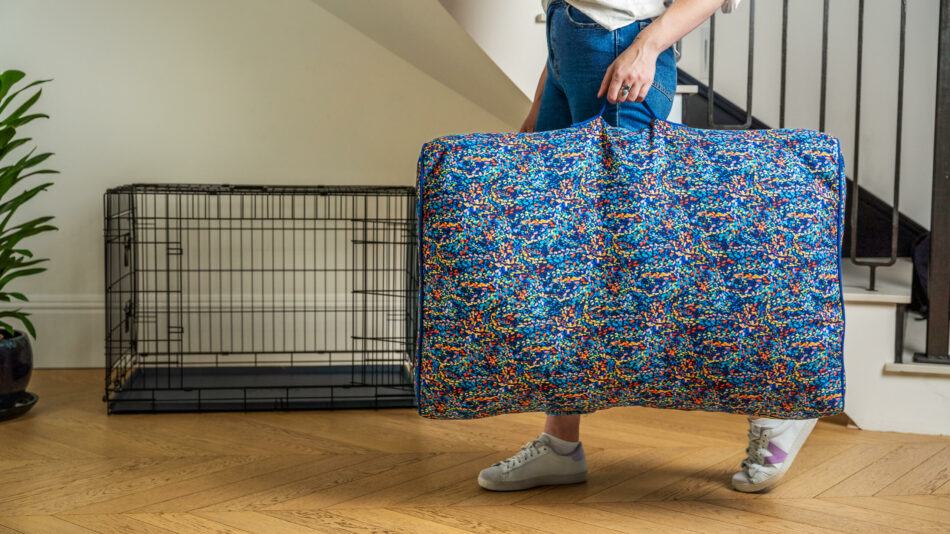

This entry was posted in Dogs on July 4th, 2018 by helenkennedy
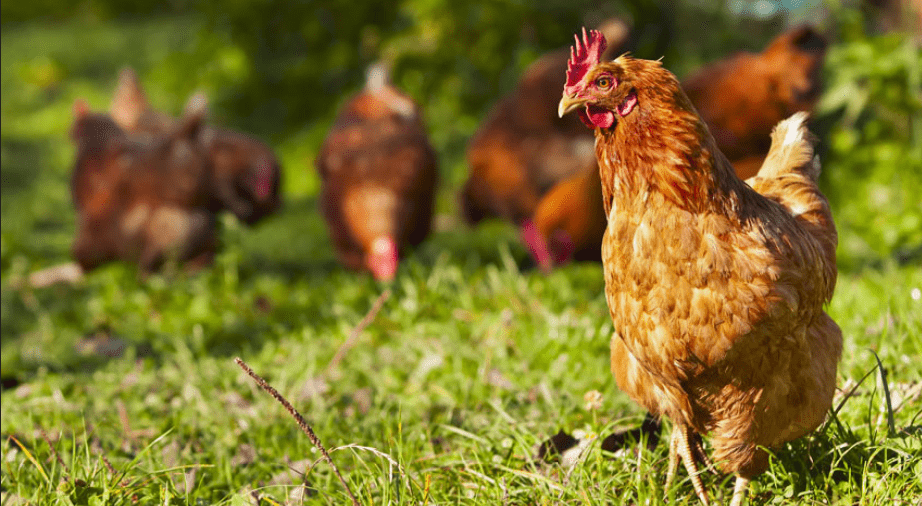
Did you know, that chickens can’t sweat? Instead, chickens use their legs, combs and wattles to lead heat away from their bodies. They also pant and spread their wings in order to get some air through those feathers. Chickens also enjoy lying down in the shade when it’s very hot, and of course they drink lots of water.
It is actually easier for chickens to keep themselves warm in winter than it is for them to cool down during the summer. It isn’t just an issue of comfort either – chickens can die of heatstroke. Since chickens have a hard time cooling themselves down, when it gets extremely hot they rely on you to help them. So, what can you do to help your chickens keep cool in the summer heat?
Here are our 7 top tips:
1) Water
Eggs consist mainly of water, so producing an egg absorbs a lot of water from a hen’s body. Drinking cool water is also one of the main ways in which chickens cool themselves down. Your chickens will therefore need lots of fresh, clean and cool water in the heat of the summer. It’s best to change the water every day to make sure they have this. It is also a good idea to provide several water sources so all your chickens can drink at the same time and don’t have to fight for access and end up dehydrating.
Another way you can use water to help your chickens cool down is by providing some shallow pools where they can dip and cool their feet and legs, remember that this is one of the areas where heat leaves their bodies. Try filling some shallow bowls or tubs and leaving them around in the run or your garden. If your chickens don’t like to stand directly in the water you can try placing a brick in there which will be cooled by the water and which the chickens can then stand on top of.
2) Shade
It is absolutely essential to provide shade for your chickens and even more so when it gets really hot. If you let your chickens free-range in the garden they might be able to find shade under trees and bushes but in any case it is a good idea to provide shade in the run as well. You can easily create shady spots in the run for instance by having a raised coop and/or attaching covers to the run.
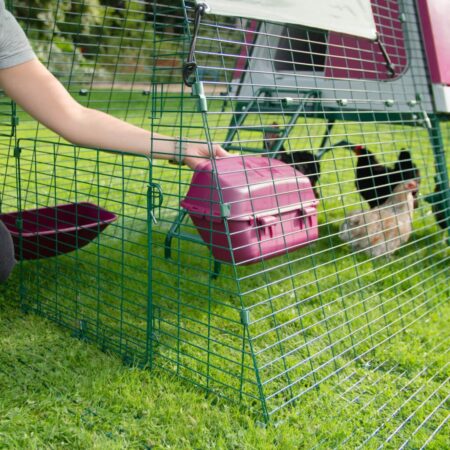 3) Feeding
3) Feeding
Be careful not to give your chickens too many treat in summer, as you need to make sure they eat their layers pellets. Chickens eat less when it’s extremely hot because digestion produces more body heat, so it’s important to make sure they eat the right things and get the vitamins and minerals they need. Try feeding your chickens during the cooler parts of the day such as in the evening. See tip #4 as well.
4) Nutritional Supplements
It is a good idea to give your hens some nutritional supplements in the heat such as vitamins and tonics which can be added directly to their food or water. These can improve absorption of minerals, give your chickens a boost to improve their overall health and help them cope better with the heat.
Apple cider vinegar, for instance, can help with calcium absorption in the body which is essential for egg shell production.
5) Dust Baths
Chickens love to dust bathe in the warm weather, but you might not want them scraping around in your flower beds. The best thing to do is to build another flower bed (but not for your flowers) and fill it with some sand, soil and some louse powder. If you have a large flock you might even want to provide several spaces so all your chickens have a chance to dust bathe in the shade.
Make sure that you place the dust bath in a sheltered spot or cover it up when your chickens aren’t using it otherwise the rain might turn it into a mud bath.
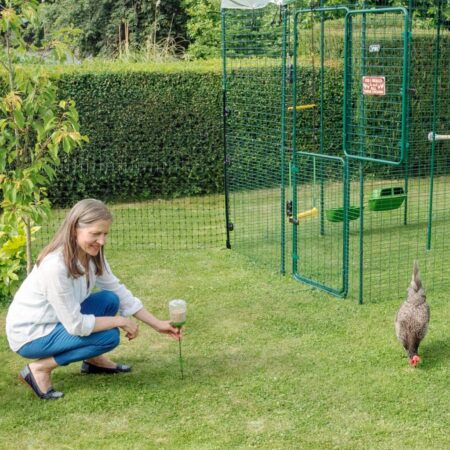 6) Space
6) Space
Your chickens will need plenty of space during the hot summer months so make sure they aren’t overcrowded. It will be even hotter for them if they are crowded too closely together. Chickens need to be able to spread out and spread their wings for ventilation, and everyone in the flock needs to be able to drink cool water and lie in the shade at any time.
7) Cool Coop
All Omlet Eglu chicken coops have a unique twin-wall insulation system which works in a similar way to double glazing. This means they do not overheat in the summer. They are also built with a draught-free ventilation system, carefully designed to avoid air blowing directly over the roosting area whilst allowing fresh air to circulate.
If you have a wooden chicken coop, it is important to think about how you can keep the coop nice and cool for your chickens. Make sure you create plenty of ventilation either by opening windows in the coop or by using a fan. Be careful not to have too much thick and heavy bedding as it absorbs heat. Also keep an eye out for mould if you’ve got a wooden coop. Mould can make straw and hay start to rot faster, thereby producing more heat, so make sure you clean out the coop regularly and especially at any signs of mould.
If your chickens are reluctant to go into the hot coop during the day to lay their eggs you could try providing nesting boxes for them outside in cooler, shaded areas.
This entry was posted in Chickens on July 2nd, 2018 by helenkennedy

Rocky is a Medical Alert Assistance Dog and a fantastic companion for 7 year old Josh who has unexplained hypoglycemia and Epilepsy and has had many hospital stays since he was born. Rocky has been trained by the Medical Detection Dogs charity to alert Josh’s family when his blood sugars drop dangerously low and could trigger a seizure.
We spoke to Josh’s mum Paula to find our more about this delightful friendship!
What type of dog is Rocky? He’s a Cockapoo
How old is he? He’ll be 2 on the 28th September. He joined our family when he was 9 weeks old.
What does Rocky do to help Josh on a daily basis?
Rocky spends all his time with Josh and alerts us when his blood sugars drop too low by sense of smell. Josh has unexplained hypoglycemia along with epilepsy and his seizures can be triggered by low blood sugar. We test Josh’s blood sugar numerous times a day but are extremely lucky to have Rocky with us who has alerted us many times when his blood sugars drop to a dangerous level which has fortunately stopped things escalating to a medical emergency. Rocky sleeps in Josh’s room and we are confident he will come and wake us if he ever senses a problem.
If Rocky wants to alert Josh, he stands on his back legs and puts his paws on Josh’s shoulder and licks his face. If Josh is asleep he comes to find me and licks my hands to wake me.
Did the Medical Detection Dog Charity advise you about what type of dog to get? We had spoken with the charity prior to buying Rocky and knew what to look for when looking for a puppy to give us the best possible chance of buying a puppy that we may be able to train successfully. Obviously we knew there were no guarantees on this and also looked for a puppy we thought would be the ‘best fit’ as our new family member.
Did you have to crate train him or was he already crate trained when you got him? We chose to crate train. He was used to a crate from being with Mum so it was very straight forward. He took his blanket in with him and was always happy. The training we did with Rocky with the crate was very easy, primarily due to him already being used to one.
During Rocky’s Medical Detection Dog training did you have to attend lots of classes? Rocky and I used to have one to one training on a weekly basis. Josh attended the training whenever possible. I would also send off any records of alerting behaviours along with all of Josh’s blood sugar recordings.
What did the training include? Where was the training held? The training was held at a variety of places. It included public access, off lead walking, heal work, distraction work etc etc. We had a train trip, a bus trip, taxi ride, public access – so inside shops, supermarkets etc, in school, busy places and quieter places, all to see how Rocky would react. And of course, a vet visit.
How long did the training take from start to finish? Rocky qualified at 18 months of age. The youngest possible age to qualify. We were training with him from the moment he came home at 9 weeks of age.
Do you have to go for additional training even now he has qualified? We have a first post qualification check 6 months from qualification and then every 12 months after. If we come across any problems at all at any point, we are fully encouraged to speak with MDD for full support wherever it is needed. We will also attend regular refresher training to ensure Rocky maintains his high standard of behaviour and alerting.
What type of treats do you feed Rocky as a reward? Rocky always has the same reward, dehydrated hotdog sausage – his absolute favourite!
Is Rocky allowed to go everywhere with Josh?
Yes he is. Rocky has to wear his ‘Medical Alert Assistance Dog’ tabbard whenever we are out in public and is allowed in all public access areas including shops, restaurants, beaches and cinemas.
Rocky and Josh are best friends. Josh trusts Rocky completely and understands that he helps to keep him safe. Rocky is simply a life changing member of our family.
—————————–
Medical Detection Dogs is a fabulous charity that trains dogs to detect the odour of human disease. It is at the forefront of the research into the fight against cancer and helping people with life-threatening diseases. To find out more about the amazing work that they do click here
If you are looking to crate train your dog, click here to find out more about the new Fido Nook 2in1 Luxury Dog Bed and Crate
This entry was posted in Dogs on July 2nd, 2018 by helenkennedy






























